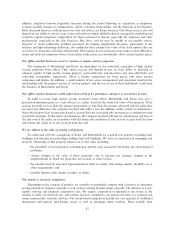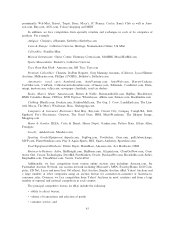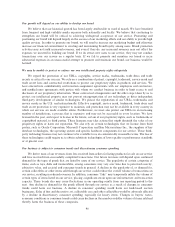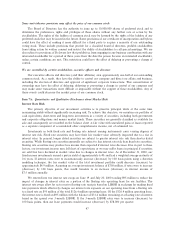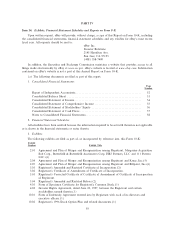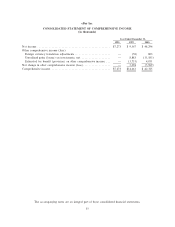eBay 2000 Annual Report Download - page 52
Download and view the complete annual report
Please find page 52 of the 2000 eBay annual report below. You can navigate through the pages in the report by either clicking on the pages listed below, or by using the keyword search tool below to find specific information within the annual report.Some anti-takeover provisions may aÅect the price of our common stock
The Board of Directors has the authority to issue up to 10,000,000 shares of preferred stock and to
determine the preferences, rights and privileges of those shares without any further vote or action by the
stockholders. The rights of the holders of common stock may be harmed by the rights of the holders of any
preferred stock that may be issued in the future. Some provisions of our certiÑcate of incorporation and bylaws
could have the eÅect of making it more diÇcult for a third party to acquire a majority of our outstanding
voting stock. These include provisions that provide for a classiÑed board of directors, prohibit stockholders
from taking action by written consent and restrict the ability of stockholders to call special meetings. We are
also subject to provisions of Delaware law that prohibit us from engaging in any business combination with any
interested stockholder for a period of three years from the date the person became an interested stockholder,
unless certain conditions are met. This restriction could have the eÅect of delaying or preventing a change of
control.
We are controlled by certain stockholders, executive oÇcers and directors
Our executive oÇcers and directors (and their aÇliates) own approximately one-half of our outstanding
common stock. As a result, they have the ability to control our company and direct our aÅairs and business,
including the election of directors and approval of signiÑcant corporate transactions. This concentration of
ownership may have the eÅect of delaying, deferring or preventing a change in control of our company and
may make some transactions more diÇcult or impossible without the support of these stockholders. Any of
these events could decrease the market price of our common stock.
Item 7A: Quantitative and Qualitative Disclosures about Market Risk
Interest Rate Risk
The primary objective of our investment activities is to preserve principal while at the same time
maximizing yields without signiÑcantly increasing risk. To achieve this objective, we maintain our portfolio of
cash equivalents, short-term and long-term investments in a variety of securities, including both government
and corporate obligations and money market funds. These securities are generally classiÑed as available for
sale and consequently are recorded on the balance sheet at fair value with unrealized gains or losses reported
as a separate component of accumulated other comprehensive income, net of estimated tax.
Investments in both Ñxed rate and Öoating rate interest earning instruments carry varying degrees of
interest rate risk. Fixed rate securities may have their fair market value adversely impacted due to a rise in
interest rates. In general, longer dated securities are subject to greater interest rate risk than shorter dated
securities. While Öoating rate securities generally are subject to less interest rate risk than Ñxed rate securities,
Öoating rate securities may produce less income than expected if interest rates decrease. Due in part to these
factors, our investment income may fall short of expectations or we may suÅer losses in principal if securities
are sold that have declined in market value due to changes in interest rates. As of December 31, 2000, our
Ñxed income investments earned a pretax yield of approximately 6.4% and had a weighted average maturity of
0.6 years. If interest rates were to instantaneously increase (decrease) by 100 basis points using a duration
modeling technique, the fair market value of the total investment portfolio could decrease (increase) by
approximately $4.9 million. Assuming an average investment balance of $750 million, if rates were to increase
(decrease) by 100 basis points, this would translate to an increase (decrease) in interest income of
$7.5 million annually.
We entered into two interest rate swaps on June 19 and July 20, 2000 totaling $95 million to reduce the
impact of changes in interest rates on a portion of the Öoating rate operating lease for our facilities. The
interest rate swaps allow for us to receive Öoating rate receipts based on LIBOR in exchange for making Ñxed
rate payments which eÅectively changes our interest rate exposure on our operating lease from a Öoating rate
to a Ñxed rate on $95 million of the total $126.4 million operating lease. Of the $126.4 million operating lease,
the interest rate is Ñxed on $95 million with the balance of $31.4 million remaining at a Öoating rate of interest
based on the spread over 3-month LIBOR. If the 3-month LIBOR rates were to increase (decrease) by
100 basis points, then our lease payments would increase (decrease) by $78,000 per quarter.
47







